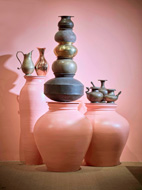POTS: As simple vessels of everyday use, our story tells of the timelessness of our beauty and the grace of our form.
In the context of Indian literature and art, we symbolise the womb, bounty, earth, woman and plenitude -- as symbolic receptacles, we hold life, spirits and the dead; water, soma and amrita.The Amara Kosha [11.2.1], one of the earliest lexicons of the Sanskrit language states that a synonym for Earth (bhu) is Kumbhini (she who is the pot).
In the physical form, we display a naturalness of shape, and specificity to function.The contour of most pots is derived from nature – like the gourd, pumpkin and lotus. Fluted melons, in particular have inspired many pots across India.
The most versatile pot, Lota, famous in design circles for having been acknowledged for its appropriateness of form and efficiency offunction is one such instance. India is dotted with thousands of such instances of functional ingenuity and graceful form.
The genius of the Indian pot can also be seen across various materials, which typically began by imitating its predecessor’s form, until achieving mastering of the new material and then innovating with it.
You could consider our attributes as the most effortless expressions of design fundamentals of form, shape, proportion, lineand function. A finely shaped pot without any surface ornamentation therefore appears perfectly ornamental. Rendering each one of us everyday objects, a virtual sculpture.
SPOUTS: Like Pots, we too were designed to fulfil specific functions. Particularly with the intent to control and temper the flow of liquid stored. For instance, spouts for water were narrow, whereas those for pouring ghee were wider. Our earliest examples are seen during Harappan times in the remnants of a terracotta spout. With the Mughal period, the elegant form of the surahi, so named, for its use for pouring Sura (intoxicating drink) gains the dual status of utility and aesthetics.




